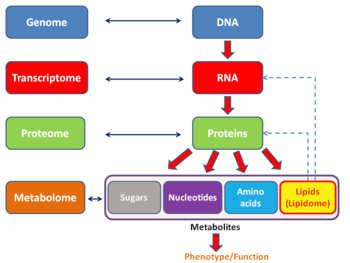Important Facts For Prelims
Pan-Transcriptome
- 21 Jan 2023
- 4 min read
Why in News?
Recently, researchers at the University of California, Santa Cruz, have proposed a “Pan-transcriptome” which combines a transcriptome and a pan-genome.
- Mapping transcriptome (complete set of RNA molecules) allows researchers to better understand an individual’s gene expression.
What is a ‘Pan-transcriptome’?
- Pan-transcriptome is a reference that contains genetic material from a cohort of diverse individuals, rather than just a single linear strand.
- The pan-transcriptome builds on the emerging concept of “pan-genomics” in the genomics field.
- Typically, when evaluating an individual’s genomic data for variation, scientists compare the individual’s genome to that of a reference made up of a single linear strand of DNA bases.
- A "pan-transcriptome" is a combination of a transcriptome and a pan-genome.
- Transcriptome:
- Pan-genome:
- A pan-genome is a reference that contains genetic material from a diverse group of individuals, rather than just a single linear strand.
- Using a pangenome allows researchers to compare an individual’s genome to that of a genetically diverse cohort of reference sequences all at once, sourced from individuals representing a diversity of biogeographic ancestry.
What is the Use of Pan-transcriptome?
- Discovery of New Genes: A pan-transcriptome can be used to identify novel genes that may not have been detected through traditional genome sequencing methods.
- Regulating Gene Expression: The Pan-transcriptome can change in response to environmental or physiological conditions, and it plays a key role in regulating gene expression.
- Characterizing Genetic Diversity: Pan-transcriptomes can be used to identify genetic variations within and between different populations of organisms.
- This can provide insights into the evolution and adaptation of different species.
What is RNA Mapping?
- About:
- RNA mapping is a technique used to identify and map the location of RNA molecules within a cell or tissue.
- It is typically used to study the expression and localization of different types of RNA, including messenger RNA (mRNA), ribosomal RNA (rRNA), and transfer RNA (tRNA).
- Method for RNA mapping:
- In- situ hybridization (ISH):
- In- situ hybridization (ISH) allows researchers to see where a specific RNA is located within a cell or tissue, and can provide insights into the function of that RNA.
- RNA-seq (RNA sequencing):
- It allows for the simultaneous analysis of thousands or even millions of RNA molecules in a sample.
- RNA-seq can be used to generate a detailed picture of the transcriptome, including the abundance and location of different RNA molecules.
- In- situ hybridization (ISH):
- Uses: This information can be used to study-
- Gene expression patterns
- Identify novel transcripts
- Detect genetic variations
UPSC Civil Services Examination, Previous Year Questions (PYQs)
Q. In the context of the developments in Bioinformatics, the term ‘transcriptome’, sometimes seen in the news, refers to (2016)
(a) a range of enzymes used in genome editing
(b) the full range of mRNA molecules expressed by an organism
(c) the description of the mechanism of gene expression
(d) a mechanism of genetic mutations taking place in cells
Ans: (b)







